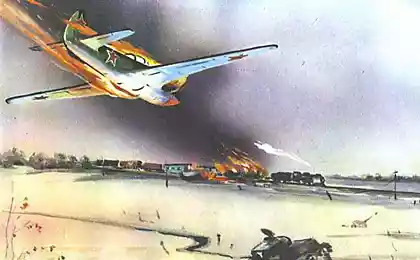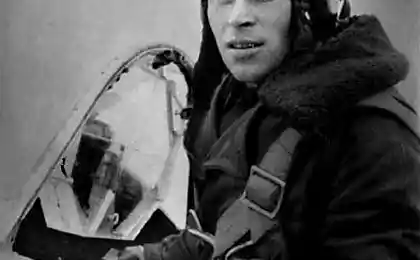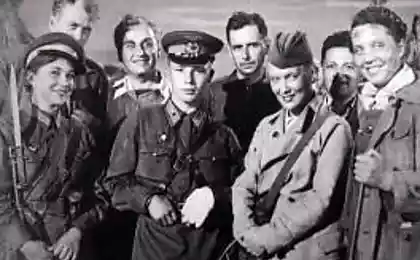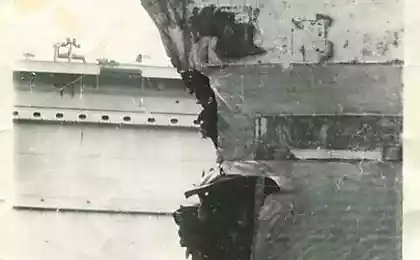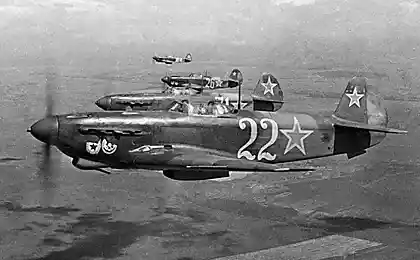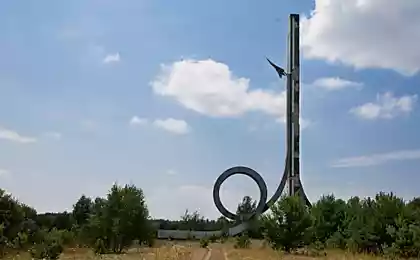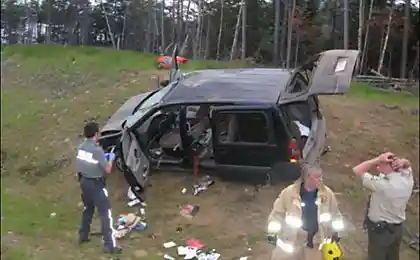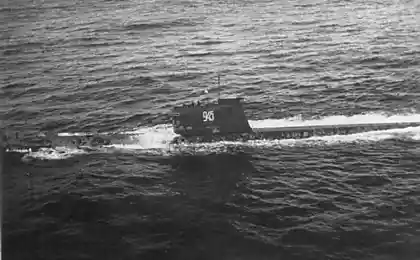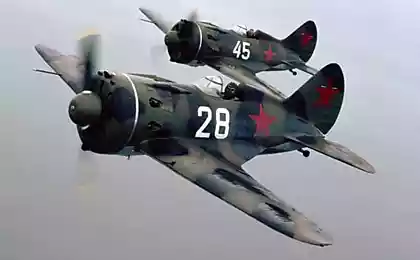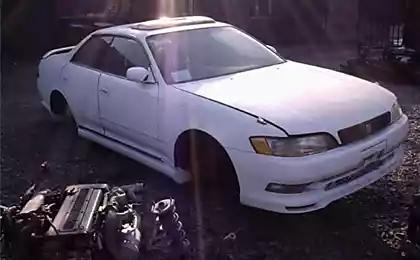1183
Air ram
Remember the war! Let distant and obscure it,
Years go by, commanders leave the reserve, -
Remember the war! This, really, is not enough -
Remember all the things that once came to us all.
Yuri Vizbor
Dictionary of Russian S.I.Ozhegova so gives a definition of the word feat - the heroic, selfless act, the importance on the value action to be taken in difficult conditions. The standard of the feat of arms has rightly become a battering ram air when the pilot, putting at stake his own life, unleashes the triumph hit his car on enemy aircraft.
Legendary pilot Pyotr Nesterov made in 1914, the first air ram.
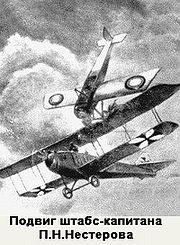
Air ram was not provided military codes, manuals or instructions. Soviet pilots have resorted to such extreme means not following orders. They moved the love for the motherland, hatred for the invaders, sense of duty and personal responsibility for the fate of the country. Air Chief Marshal of the Soviet Union twice Hero A.A.Novikov, a former Air Force Commander in the 1942-1946's, so to say, "ram air - is not only a lightning calculation, exceptional courage and self-control. Taran in the sky - is primarily a self-sacrifice, the ultimate test of loyalty to his people, to his ideals. This is one of the highest forms of manifestation of the moral factor inherent in Soviet man that's just did not consider and could not consider an enemy. »
During the Great Patriotic War, Soviet pilots flew more than 600 rams (the exact number is unknown as investigations continue and gradually become known to all new cases). More than 2/3 of them in 1941-1942 - the most difficult period of the war. At that time, part of the Luftwaffe was even sent out a circular forbidding approach to Soviet aircrafts closer than 100 meters to avoid ramming.
Soviet pilots used a battering ram on all types of aircraft: fighters, attack planes, bombers, reconnaissance aircraft. Rams committed in group and individual battles, day and night, clear skies and clouds at low and high altitudes, and over its territory and over enemy territory.
There are quite a widespread view that the ram - is a fatal act of self-sacrifice.
But here's what he wrote Alexei Tolstoy in one of his wartime essays, which is called - "Taran", "Soviet pilot never shies away from a fight, and the closer to it the danger, the angrier his heart, the prudence of its motion, the faster his reflexes ... Soviet pilots have created a new form of attack, the Nazis did not dare to use it. I'm talking about taranenii airborne enemy while maintaining not only their lives, but in some cases their car. »
Indeed, statistics show that in the commission of a battering ram killed about 37% of pilots. The rest were not only alive, but many continued to fight and landing on his plane. There are cases where pilots made two ram in one battle. Several dozen people have committed so-called "double" rams when the first attempt to shoot down enemy aircraft and had not been able to finish his repeated ramming attack. Known even a case where a fighter pilot O.Kilgovatovu to destroy the enemy, had to apply four ramming attack. 35 pilots made two ram, and N.V.Terёhin A.S.Hlobystov - three, B.I.Kovzan - four.
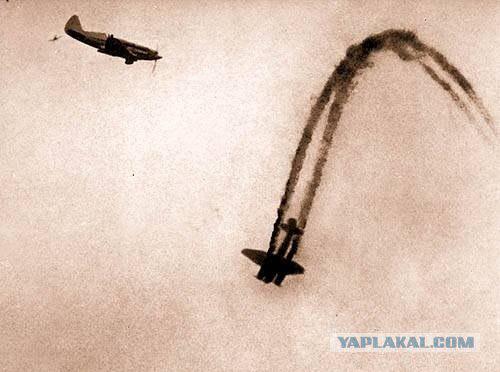
Terekhin NV
Born in 1916 in the village of Cherdyn Lopatinskii district of the Penza region. Russian. Member of the CPSU (b).
Squadron 161 th Fighter Regiment (43 th Fighter Division, Western Front) Lieutenant Terekhin NV the morning of July 10th, 1941 at the head of unit-16 flew reflection raid of enemy bombers to the airfield. Above the town of Six Mogilev-16 has led the fight to the enemy group Ju-88 bombers. Link Terekhina rushed to their aid. He himself chose his target and attack it. He has spent the entire ammunition, but the "Junkers" continued to fly. In order not to let him go, Terekhin decided to ram. He came close to the enemy and screw cut off his tail feathers. Bombers were tight formation. Falling, "Junkers" hit the wing of his master. The two enemy aircraft crashed to the ground. Terekhin landed by parachute. Near landed the crew shot down "Junkers". More in the air the Germans opened fire with handguns. Terekhin shot back. To the place of landing arrived, farmers who helped disarm and bind the Nazis. On the KP division Terekhin appeared with a gun in his hand and a rope that had been tied prisoners - in the other. For this feat he was awarded the Order of Lenin.
July 18, 1941 in an air battle on the approaches to Leningrad ramming attack enemy aircraft shot down the third.
Major Terekhin died in a dogfight December 30, 1942. Total has made 250 sorties, shot down 17 enemy aircraft.
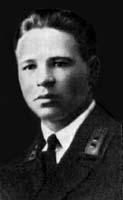
Khlobystov Alex Stepanovich
Born February 23, 1918 in the village of Zakharov (now the village Elin Zaharovskaya region Ryazan region) in a peasant family. Russian. Member of the CPSU (b) since April 1942. He graduated from the 7 classes of junior high school. After the death of his father to his sister moved to Moscow. An apprentice electrician at Karacharovsky Mechanical Plant. Then he worked in the Research Institute of Metallurgical Engineering and also studied at the flying club Ukhtomsky. In the Red Army in 1939. In 1941 he graduated from the 1-S Kachin Red Banner military aviation school pilots the AF Myasnikov.
On the Great Patriotic War from day one. He fought on the Karelian Isthmus. His fighting account was opened June 28, 1941, destroying the dive bomber Ju-87. In the fall of 1941 in an air battle he shot down his fourth plane, but he was forced to sit on the tops of the pines. One month in hospital. He was awarded the Order of the Red Banner. Then he fought on the Volkhov front. In January 1942, he arrived in the 147th Fighter Aviation Regiment of the Karelian Front.
Commander of the 20th Guards Fighter Aviation Regiment (1st Composite Air Division, Air Force 14th Army, Karelian Front) Guard Lieutenant Khlobystov AS in April 1942, he made 266 sorties to attack enemy troops. In 16 air battles personally shot down 4 and Group 6 enemy planes.
April 8, 1942 he was accepted as a member of the CPSU (b). During the meeting, he received an order to take off. Posts VNOS found a large group of enemy planes on their way to Murmansk. On the interception was raised of Six fighter the P-40 "Tomahawk-IIB» under the command of the Guard Captain Pozdnyakov AP In the area of the village Restikent our pilots found 15 bomber Ju-87 undercover 5 fighters Me-110. Thrust dogfight ensued. During the battle plane Guard lieutenant Fateev ID He was attacked by "Messerschmitt". He came to the aid pilots Bychkov EM and VR Semenkov Fleeing from their machine-gun bursts, the Germans turned away and faced Hlobystova. Time was not on the sighting. Not wanting to miss a nazi unscathed, he left the plane his plane hit the tail "Messerschmitt". He lost control, crashed into a hill. Then fire from weapons onboard Khlobystov shot down another aircraft. Soon, the Germans came reinforcements: 8 "Messerschmitt". At a critical moment in the battle to ram went to Captain Pozdnyakov and thus died. Wanting to avenge their commander, Khlobystov converged in a frontal attack with two "Messerschmitt" and applied the second ram, hitting one of them again right plane. On damaged, barely controlled plane held up his airfield and successfully made a landing.
May 14, 1942 Senior Lieutenant Khlobystov flew in a group of fighters reflection flying enemy aircraft to Murmansk. In the first minutes of the fight, he was wounded in the arm and leg. He puffed and immediately broke the motor. Abrupt maneuvers Khlobystov tried to extinguish the flames, but to no avail. Noting that the aircraft captain Solomon VD attacking Me-109, he dovernul his plane, increased gas and ramming attack to destroy the enemy. The blow Hlobystova ejected from the cab through the open lantern. Losing consciousness, he managed to open the parachute. June 6, 1942 he was awarded the title Hero of the Soviet Union.
Guard Captain Khlobystov AS He died in a dogfight December 13, 1943. By this time he made 335 sorties, shot down seven enemy planes in person and 24 in group combat. He was awarded the Order of Lenin, 2 orders of the Red Banner, medals. In the name of Hero of the streets were named in Murmansk and Moscow, submarine depot ship CSF sea fishing boat, Pioneer squads. On the territory of the Research Institute, where he worked Khlobystov, erected a bust. Another bust was installed in 1995 in Moscow on the street named after him. The shop Karacharovsky mechanical plant a memorial plaque.
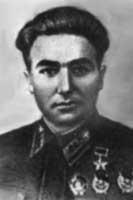
Kovzan Boris
Born April 7, 1922 in the city of Mines is now the Rostov region in a family servant. Russian. Member of the CPSU since 1945. He graduated from the 8 classes in the town of Bobruisk, Mogilev region. In the Red Army in 1939. He graduated from the Odessa Military Aviation Pilot School.
Member of the Great Patriotic War in 1941. Pilot 42 Fighter Regiment (Bryansk Front) Komsomolets Lieutenant Kovzan BI Battle your account was opened in August 1941, shooting down the bomber Do-215.
October 29, 1941 on the MiG-3 flew in support of ground attack near the town of Zagorsk, Moscow Region. In the air battle with 4 Me-109 shot down one of them, but I spent the entire ammunition. When returning to their base at an altitude of 5000 m found an air reconnaissance of the enemy Ju-88. In order not to let him go, Kovzan decided to ram. He went "Junkers" back of the bottom and level the speed. Then he opened the throttle handle and abruptly took over. The blow shook the entire fighter, but Kovzan lost control. "Junkers", tumbling, went to the ground. I made a landing at its airport.
February 22, 1942 Lieutenant Kovzan in the area of the Most High Volochek on Yak-1 bomber rammed an enemy. I made a landing on the damaged plane.
July 8, 1942 in the village of Lobnitsy Novgorod region in a dogfight on the same plane rammed an enemy fighter. He landed on the damaged plane.
The pilot of the same regiment (240 th Fighter Division, 6 th Air Army, the North-Western Front) Lieutenant Kovzan BI by the middle of July 1942 he made 142 sorties, shot down 3 and in group 1 enemy aircraft. August 24, 1943 he was awarded the title Hero of the Soviet Union.
August 13, 1942 near the city of Staraya Russa captain Kovzan aircraft La-5 found a group of 7 Ju-88 and 6, Me-109. The enemy has already noticed our fighter and Kovzanu had to enter into an unequal battle. Not paying attention to the fighter escort, Kovzan rushed to the "Junkers". One Me-109 tried to stand in his way, but after the tag line puffed and began to fall. Suddenly, the enemy of all struck by the cab. One bullet hit Kovzanu in the right eye. He tried to jump out with a parachute, but the strength is not enough. At this time, straight ahead seemed "Junkers" and Kovzan directed his burning plane on it. From the impact, both aircraft fell apart. Our pilot was thrown from the cockpit through the open lantern. With a height of 6,000 meters, he fell into a swamp and it saved his life. In the fall he broke his left leg, arm and several ribs. It was his fourth in a row ram.
Came to the rescue farmers pulled the pilot out of the mire and took him to the partisans, and they sent him across the front line. Kovzan 10 months spent in hospitals. After the hospital obtained permission to serve with one eye in fighter aircraft. By the end of the war brought down another 6 enemy aircraft, bringing a personal score to 28.
After the war he continued service in the aviation industry. In 1954 he graduated from the Air Force Academy. Since 1958, Lieutenant Colonel Kovzan - in stock. He lived in Ryazan, worked as head of the flying club. Then, a retired colonel Kovzan lived in Minsk. He was awarded two Orders of Lenin, Order of the Red Banner, World War 1 degree, the Red Star and medals. He died August 31, 1985. Plaques installed in Ryazan and Minsk.

Among the Soviet pilots who committed rams were representatives of various nationalities: Russian, Ukrainians, Belarusians, Georgians, Jews, Armenians, Azerbaijanis, Moldavians, Poles, Tatars, Chuvash. Soveshali rams citizens of other countries: English, Chinese, Spanish, French, Bulgarians, Greeks, Poles, Yugoslavs, Germans, Italians, Japanese. In the Soviet Union, Germany and even the United States have developed projects for the application of special planes ramming (L.Golovina rocket plane, Ba.349, Northrop XP-79), but in practice they have not been realized (it was built a small series Ba.349A, but in combat they are not used).
Separately, it must be said about the Japanese kamikazes. Although, in fairness, it should be noted that not all of the Japanese pilots who committed rams were suicide bombers. The status of the kamikaze were required to make rams, with the goal chosen to command, and he could only meekly to perform the role of a suicide bomber. At the end of the war in the air defense of Tokyo there was even spetsialny Regiment (244th Sentai), which pilots had to shoot down American bombers rammed.

Few people know that even before the Japanese have organized something like this at the Germans. In 1944, the air defense of the Reich there were special groups of hunters ("ramyagger"), completed with volunteers and penalty box. Penal signed a commitment in each fight shoot down enemy bombers on. If you did not have enough ammunition, they had to go to the ram. The default is seen as "cowardice in the face of the enemy».
In early 1945, H. Oberst-I.Herrman put forward the idea of mass Collision attacks against Allied bombers. It was supposed to use up to 2,000 lightweight Bf.109G-10 and K-1. On his initiative, a special training school for Kamikaze pilots - training "Elba". The case put into practice the idea Herrmann had the day April 7, 1945 in the area of Magdeburg. However, due to various problems of organizational and economic nature in the attack attended by only 120 "Messerschmitt". In total, this day has been applied 23 ramming attack. This 8 American bombers were shot down. The rest, in spite of the significant damage, was able to hold on to their airfields or make an emergency landing on its territory.
The first who theorized the possibility of a battering ram, was the Russian aviator N.A.Yatsuk. The journal "Bulletin of aeronautics» №13-14 for 1911, he published a short note about the use of military airplanes, which suggested that he, too, airplane weapon. Along with the prediction of the appearance on aircraft artillery, machine guns and bombs, he wrote: "It is possible that in exceptional cases, the pilots will be decided to ram their airplanes someone else." In April 1911 at the I All-Russia aeronautic Congress he made two presentations. At this congress was attended by Lieutenant Artillery Brigade P.N.Nesterov. That's when he first heard of the ram air, which subsequently he first had to apply in practice. Later, they became friends with Jatsuk.
In 1924 he published a work on Jatsuk taktive military aviation. The common thread in it is the idea of the ram air: & quot; ... This appointment will be in the tactics of air combat hero of last resort ... maneuver marks the threat ram - a powerful tool for moral effect on the enemy & quot ;.
There are different ways of application ramming attack. Pilots struck the wheels of the chassis, screw on the tail unit, which plane or on a plane fuselage and, finally, the whole weight of its aircraft.
Blow gear wheels.
Ramming method, in which the strike is applied on top of the chassis wheels on the wing, offered P.N.Nesterov. The very design of the aircraft, which were mostly wooden biplanes with fixed landing gear, contributed to this. Trying very Nesterov implement this method was unsuccessful, he calculated the speed of convergence is not and his plane crashed into a motor between enemy planes.
Six months later, the idea Nesterov realized another Russian pilot - Lieutenant-Captain A.A.Kazakov. In the same way he rammed a German O.Henritsi.
Blow propeller
More in 1925 during an exercise Valery Chkalov witnessed the accident, when taxiing on the airfield the aircraft collided with another. This stands aircraft shall be cut rotary screw, and the perpetrator of the accident unhurt. Chkalov remembered it and decided the case when used in combat. Such is the case it will soon provide. One day, during a training exercise, he flew on a mission to shoot down the target - a balloon. After several unsuccessful attempts to shoot the ball from a machine gun, he slashed it with the screw. Blow wing
Beat the wing could be applied on the wing, on the tail unit, the fuselage (in particular the cockpit) aircraft of the enemy in a frontal attack, and in the course of the Dogon.
Dobavleno1 in [mergetime] 1277065589 [/ mergetime]
Punch fuselage
It is the most risky way to ramming.
5 minutes.
Source:
Years go by, commanders leave the reserve, -
Remember the war! This, really, is not enough -
Remember all the things that once came to us all.
Yuri Vizbor
Dictionary of Russian S.I.Ozhegova so gives a definition of the word feat - the heroic, selfless act, the importance on the value action to be taken in difficult conditions. The standard of the feat of arms has rightly become a battering ram air when the pilot, putting at stake his own life, unleashes the triumph hit his car on enemy aircraft.
Legendary pilot Pyotr Nesterov made in 1914, the first air ram.

Air ram was not provided military codes, manuals or instructions. Soviet pilots have resorted to such extreme means not following orders. They moved the love for the motherland, hatred for the invaders, sense of duty and personal responsibility for the fate of the country. Air Chief Marshal of the Soviet Union twice Hero A.A.Novikov, a former Air Force Commander in the 1942-1946's, so to say, "ram air - is not only a lightning calculation, exceptional courage and self-control. Taran in the sky - is primarily a self-sacrifice, the ultimate test of loyalty to his people, to his ideals. This is one of the highest forms of manifestation of the moral factor inherent in Soviet man that's just did not consider and could not consider an enemy. »
During the Great Patriotic War, Soviet pilots flew more than 600 rams (the exact number is unknown as investigations continue and gradually become known to all new cases). More than 2/3 of them in 1941-1942 - the most difficult period of the war. At that time, part of the Luftwaffe was even sent out a circular forbidding approach to Soviet aircrafts closer than 100 meters to avoid ramming.
Soviet pilots used a battering ram on all types of aircraft: fighters, attack planes, bombers, reconnaissance aircraft. Rams committed in group and individual battles, day and night, clear skies and clouds at low and high altitudes, and over its territory and over enemy territory.
There are quite a widespread view that the ram - is a fatal act of self-sacrifice.
But here's what he wrote Alexei Tolstoy in one of his wartime essays, which is called - "Taran", "Soviet pilot never shies away from a fight, and the closer to it the danger, the angrier his heart, the prudence of its motion, the faster his reflexes ... Soviet pilots have created a new form of attack, the Nazis did not dare to use it. I'm talking about taranenii airborne enemy while maintaining not only their lives, but in some cases their car. »
Indeed, statistics show that in the commission of a battering ram killed about 37% of pilots. The rest were not only alive, but many continued to fight and landing on his plane. There are cases where pilots made two ram in one battle. Several dozen people have committed so-called "double" rams when the first attempt to shoot down enemy aircraft and had not been able to finish his repeated ramming attack. Known even a case where a fighter pilot O.Kilgovatovu to destroy the enemy, had to apply four ramming attack. 35 pilots made two ram, and N.V.Terёhin A.S.Hlobystov - three, B.I.Kovzan - four.

Terekhin NV
Born in 1916 in the village of Cherdyn Lopatinskii district of the Penza region. Russian. Member of the CPSU (b).
Squadron 161 th Fighter Regiment (43 th Fighter Division, Western Front) Lieutenant Terekhin NV the morning of July 10th, 1941 at the head of unit-16 flew reflection raid of enemy bombers to the airfield. Above the town of Six Mogilev-16 has led the fight to the enemy group Ju-88 bombers. Link Terekhina rushed to their aid. He himself chose his target and attack it. He has spent the entire ammunition, but the "Junkers" continued to fly. In order not to let him go, Terekhin decided to ram. He came close to the enemy and screw cut off his tail feathers. Bombers were tight formation. Falling, "Junkers" hit the wing of his master. The two enemy aircraft crashed to the ground. Terekhin landed by parachute. Near landed the crew shot down "Junkers". More in the air the Germans opened fire with handguns. Terekhin shot back. To the place of landing arrived, farmers who helped disarm and bind the Nazis. On the KP division Terekhin appeared with a gun in his hand and a rope that had been tied prisoners - in the other. For this feat he was awarded the Order of Lenin.
July 18, 1941 in an air battle on the approaches to Leningrad ramming attack enemy aircraft shot down the third.
Major Terekhin died in a dogfight December 30, 1942. Total has made 250 sorties, shot down 17 enemy aircraft.

Khlobystov Alex Stepanovich
Born February 23, 1918 in the village of Zakharov (now the village Elin Zaharovskaya region Ryazan region) in a peasant family. Russian. Member of the CPSU (b) since April 1942. He graduated from the 7 classes of junior high school. After the death of his father to his sister moved to Moscow. An apprentice electrician at Karacharovsky Mechanical Plant. Then he worked in the Research Institute of Metallurgical Engineering and also studied at the flying club Ukhtomsky. In the Red Army in 1939. In 1941 he graduated from the 1-S Kachin Red Banner military aviation school pilots the AF Myasnikov.
On the Great Patriotic War from day one. He fought on the Karelian Isthmus. His fighting account was opened June 28, 1941, destroying the dive bomber Ju-87. In the fall of 1941 in an air battle he shot down his fourth plane, but he was forced to sit on the tops of the pines. One month in hospital. He was awarded the Order of the Red Banner. Then he fought on the Volkhov front. In January 1942, he arrived in the 147th Fighter Aviation Regiment of the Karelian Front.
Commander of the 20th Guards Fighter Aviation Regiment (1st Composite Air Division, Air Force 14th Army, Karelian Front) Guard Lieutenant Khlobystov AS in April 1942, he made 266 sorties to attack enemy troops. In 16 air battles personally shot down 4 and Group 6 enemy planes.
April 8, 1942 he was accepted as a member of the CPSU (b). During the meeting, he received an order to take off. Posts VNOS found a large group of enemy planes on their way to Murmansk. On the interception was raised of Six fighter the P-40 "Tomahawk-IIB» under the command of the Guard Captain Pozdnyakov AP In the area of the village Restikent our pilots found 15 bomber Ju-87 undercover 5 fighters Me-110. Thrust dogfight ensued. During the battle plane Guard lieutenant Fateev ID He was attacked by "Messerschmitt". He came to the aid pilots Bychkov EM and VR Semenkov Fleeing from their machine-gun bursts, the Germans turned away and faced Hlobystova. Time was not on the sighting. Not wanting to miss a nazi unscathed, he left the plane his plane hit the tail "Messerschmitt". He lost control, crashed into a hill. Then fire from weapons onboard Khlobystov shot down another aircraft. Soon, the Germans came reinforcements: 8 "Messerschmitt". At a critical moment in the battle to ram went to Captain Pozdnyakov and thus died. Wanting to avenge their commander, Khlobystov converged in a frontal attack with two "Messerschmitt" and applied the second ram, hitting one of them again right plane. On damaged, barely controlled plane held up his airfield and successfully made a landing.
May 14, 1942 Senior Lieutenant Khlobystov flew in a group of fighters reflection flying enemy aircraft to Murmansk. In the first minutes of the fight, he was wounded in the arm and leg. He puffed and immediately broke the motor. Abrupt maneuvers Khlobystov tried to extinguish the flames, but to no avail. Noting that the aircraft captain Solomon VD attacking Me-109, he dovernul his plane, increased gas and ramming attack to destroy the enemy. The blow Hlobystova ejected from the cab through the open lantern. Losing consciousness, he managed to open the parachute. June 6, 1942 he was awarded the title Hero of the Soviet Union.
Guard Captain Khlobystov AS He died in a dogfight December 13, 1943. By this time he made 335 sorties, shot down seven enemy planes in person and 24 in group combat. He was awarded the Order of Lenin, 2 orders of the Red Banner, medals. In the name of Hero of the streets were named in Murmansk and Moscow, submarine depot ship CSF sea fishing boat, Pioneer squads. On the territory of the Research Institute, where he worked Khlobystov, erected a bust. Another bust was installed in 1995 in Moscow on the street named after him. The shop Karacharovsky mechanical plant a memorial plaque.

Kovzan Boris
Born April 7, 1922 in the city of Mines is now the Rostov region in a family servant. Russian. Member of the CPSU since 1945. He graduated from the 8 classes in the town of Bobruisk, Mogilev region. In the Red Army in 1939. He graduated from the Odessa Military Aviation Pilot School.
Member of the Great Patriotic War in 1941. Pilot 42 Fighter Regiment (Bryansk Front) Komsomolets Lieutenant Kovzan BI Battle your account was opened in August 1941, shooting down the bomber Do-215.
October 29, 1941 on the MiG-3 flew in support of ground attack near the town of Zagorsk, Moscow Region. In the air battle with 4 Me-109 shot down one of them, but I spent the entire ammunition. When returning to their base at an altitude of 5000 m found an air reconnaissance of the enemy Ju-88. In order not to let him go, Kovzan decided to ram. He went "Junkers" back of the bottom and level the speed. Then he opened the throttle handle and abruptly took over. The blow shook the entire fighter, but Kovzan lost control. "Junkers", tumbling, went to the ground. I made a landing at its airport.
February 22, 1942 Lieutenant Kovzan in the area of the Most High Volochek on Yak-1 bomber rammed an enemy. I made a landing on the damaged plane.
July 8, 1942 in the village of Lobnitsy Novgorod region in a dogfight on the same plane rammed an enemy fighter. He landed on the damaged plane.
The pilot of the same regiment (240 th Fighter Division, 6 th Air Army, the North-Western Front) Lieutenant Kovzan BI by the middle of July 1942 he made 142 sorties, shot down 3 and in group 1 enemy aircraft. August 24, 1943 he was awarded the title Hero of the Soviet Union.
August 13, 1942 near the city of Staraya Russa captain Kovzan aircraft La-5 found a group of 7 Ju-88 and 6, Me-109. The enemy has already noticed our fighter and Kovzanu had to enter into an unequal battle. Not paying attention to the fighter escort, Kovzan rushed to the "Junkers". One Me-109 tried to stand in his way, but after the tag line puffed and began to fall. Suddenly, the enemy of all struck by the cab. One bullet hit Kovzanu in the right eye. He tried to jump out with a parachute, but the strength is not enough. At this time, straight ahead seemed "Junkers" and Kovzan directed his burning plane on it. From the impact, both aircraft fell apart. Our pilot was thrown from the cockpit through the open lantern. With a height of 6,000 meters, he fell into a swamp and it saved his life. In the fall he broke his left leg, arm and several ribs. It was his fourth in a row ram.
Came to the rescue farmers pulled the pilot out of the mire and took him to the partisans, and they sent him across the front line. Kovzan 10 months spent in hospitals. After the hospital obtained permission to serve with one eye in fighter aircraft. By the end of the war brought down another 6 enemy aircraft, bringing a personal score to 28.
After the war he continued service in the aviation industry. In 1954 he graduated from the Air Force Academy. Since 1958, Lieutenant Colonel Kovzan - in stock. He lived in Ryazan, worked as head of the flying club. Then, a retired colonel Kovzan lived in Minsk. He was awarded two Orders of Lenin, Order of the Red Banner, World War 1 degree, the Red Star and medals. He died August 31, 1985. Plaques installed in Ryazan and Minsk.

Among the Soviet pilots who committed rams were representatives of various nationalities: Russian, Ukrainians, Belarusians, Georgians, Jews, Armenians, Azerbaijanis, Moldavians, Poles, Tatars, Chuvash. Soveshali rams citizens of other countries: English, Chinese, Spanish, French, Bulgarians, Greeks, Poles, Yugoslavs, Germans, Italians, Japanese. In the Soviet Union, Germany and even the United States have developed projects for the application of special planes ramming (L.Golovina rocket plane, Ba.349, Northrop XP-79), but in practice they have not been realized (it was built a small series Ba.349A, but in combat they are not used).
Separately, it must be said about the Japanese kamikazes. Although, in fairness, it should be noted that not all of the Japanese pilots who committed rams were suicide bombers. The status of the kamikaze were required to make rams, with the goal chosen to command, and he could only meekly to perform the role of a suicide bomber. At the end of the war in the air defense of Tokyo there was even spetsialny Regiment (244th Sentai), which pilots had to shoot down American bombers rammed.

Few people know that even before the Japanese have organized something like this at the Germans. In 1944, the air defense of the Reich there were special groups of hunters ("ramyagger"), completed with volunteers and penalty box. Penal signed a commitment in each fight shoot down enemy bombers on. If you did not have enough ammunition, they had to go to the ram. The default is seen as "cowardice in the face of the enemy».
In early 1945, H. Oberst-I.Herrman put forward the idea of mass Collision attacks against Allied bombers. It was supposed to use up to 2,000 lightweight Bf.109G-10 and K-1. On his initiative, a special training school for Kamikaze pilots - training "Elba". The case put into practice the idea Herrmann had the day April 7, 1945 in the area of Magdeburg. However, due to various problems of organizational and economic nature in the attack attended by only 120 "Messerschmitt". In total, this day has been applied 23 ramming attack. This 8 American bombers were shot down. The rest, in spite of the significant damage, was able to hold on to their airfields or make an emergency landing on its territory.
The first who theorized the possibility of a battering ram, was the Russian aviator N.A.Yatsuk. The journal "Bulletin of aeronautics» №13-14 for 1911, he published a short note about the use of military airplanes, which suggested that he, too, airplane weapon. Along with the prediction of the appearance on aircraft artillery, machine guns and bombs, he wrote: "It is possible that in exceptional cases, the pilots will be decided to ram their airplanes someone else." In April 1911 at the I All-Russia aeronautic Congress he made two presentations. At this congress was attended by Lieutenant Artillery Brigade P.N.Nesterov. That's when he first heard of the ram air, which subsequently he first had to apply in practice. Later, they became friends with Jatsuk.
In 1924 he published a work on Jatsuk taktive military aviation. The common thread in it is the idea of the ram air: & quot; ... This appointment will be in the tactics of air combat hero of last resort ... maneuver marks the threat ram - a powerful tool for moral effect on the enemy & quot ;.
There are different ways of application ramming attack. Pilots struck the wheels of the chassis, screw on the tail unit, which plane or on a plane fuselage and, finally, the whole weight of its aircraft.
Blow gear wheels.
Ramming method, in which the strike is applied on top of the chassis wheels on the wing, offered P.N.Nesterov. The very design of the aircraft, which were mostly wooden biplanes with fixed landing gear, contributed to this. Trying very Nesterov implement this method was unsuccessful, he calculated the speed of convergence is not and his plane crashed into a motor between enemy planes.
Six months later, the idea Nesterov realized another Russian pilot - Lieutenant-Captain A.A.Kazakov. In the same way he rammed a German O.Henritsi.
Blow propeller
More in 1925 during an exercise Valery Chkalov witnessed the accident, when taxiing on the airfield the aircraft collided with another. This stands aircraft shall be cut rotary screw, and the perpetrator of the accident unhurt. Chkalov remembered it and decided the case when used in combat. Such is the case it will soon provide. One day, during a training exercise, he flew on a mission to shoot down the target - a balloon. After several unsuccessful attempts to shoot the ball from a machine gun, he slashed it with the screw. Blow wing
Beat the wing could be applied on the wing, on the tail unit, the fuselage (in particular the cockpit) aircraft of the enemy in a frontal attack, and in the course of the Dogon.
Dobavleno1 in [mergetime] 1277065589 [/ mergetime]
Punch fuselage
It is the most risky way to ramming.
5 minutes.
Source:
